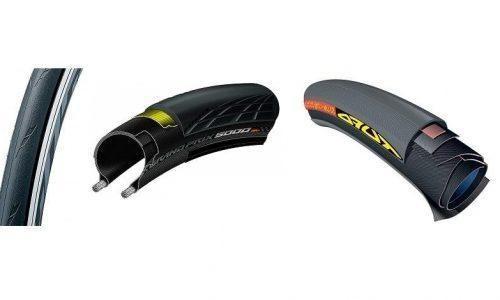When it comes to road bike tires these days, the options are endless. It can be a full day’s worth of work just finding out about all the options that are available on the market!
Everybody knows that time would better be spent riding, so we have compiled a list of some of the best (clincher) tires available for a variety of riders in order to help make your decision easier and make your ride more enjoyable.
Tires are one of those things that are often overlooked when it comes to road bikes. Everybody gets so caught up with carbon fiber upgrades, clipless pedals, etc. that they end up forgetting about their tire selection.
Tires can really make or break your ride. They inspire confidence in the corners and help you feel fast on the straights.
For those of you just looking for some suggestions, we will now list our recommended tires for riders on a budget, riders looking for increased puncture resistance, and riders who are looking for a fast, race-oriented tire.
After that, we will break down what makes a good tire good, and then we will dive deeper into our picks and explain why we chose what we did. Without further ado, here are our top choices:
Best clincher tire for cyclists on a budget: Vittoria Zaffiro IV

This is my preferred tire of choice when I am looking for an affordable tire that won’t break the bank, but still provide a decent ride quality.
This tire isn’t going to feel quite as fast as other choices, but it offers good puncture resistance, relatively low rolling resistance, and lasts for quite a while.
I have ridden these tires over 1000 miles with minimal flats and would not hesitate to recommend these to anybody looking for some fresh tires for their bike.
Best tire for cyclists looking for puncture resistance: Continental Gatorskin
What can I say, the Continental Gatorskins are considered the gold-standard of puncture resistance for a reason. These are some of the toughest road bike tires out there, and they are very popular with commuters for that reason.
If you find yourself doing a lot of riding in the city, these tires are going to be perfect for you. Glass, nails, and other debris stand no chance due to the extra tough rubber compound and strong sidewalls.
These tires are definitely going to have a little bit more rolling resistance, but that slight loss in efficiency does not even begin to compare to the amount of time lost changing a flat.
If you are a commuter, or just an avid city rider who is sick of flats, I would definitely recommend checking these out.
Best high-end tire: Vittoria Corsa G+

These Vittoria tires are different than the standard Vittoria Corsas you may have seen before. The G+ means it has its “Graphene 2.0” rubber compound.
I personally own these tires and have put a few hundred miles on them and let me tell you- it really makes a difference.
The Graphene is supposed to offer less rolling resistance, and I would say that I have experienced that. Coming from my old favorite, the Continental Grand Prix 4000s II, these tires are noticeably noisier and roll faster.
I think the noise has something to do with the Graphene rubber compound. They sound higher pitched when they are rolling down the road compared to standard tires.
It is not anything noticeable, but worth mentioning. The casing on these tires is 320TPI, which makes for a very supple tire as well.
What Makes a Good Road Tire
Now that we have gotten our picks out of the way, let’s talk a bit about what really makes a tire worth 3 or 4 times more than a different tire, and why or why not you should spend the extra money.
Rubber compound: The rubber that the tire’s contact surface is made out of is known as the rubber compound. Different compounds have different characteristics, similar to how summer tires for your car are different than all-season tires, which are different than snow tires.
Some compounds are harder and offer increased puncture resistance but might sacrifice cold-weather performance or grip on wet roads. Others are softer, and offer more grip, but may have more rolling resistance or wear down faster, which means you will need to replace them sooner.
Casing: Casing is measured in TPI, or threads per inch. The higher the number, the softer and suppler the tire will ride.
It will also handle better overall, absorbing the road vibrations better and increasing grip by conforming with the road surface better than a tire with lower TPI. This can get expensive pretty quickly, so you usually will see small jumps in TPI associated with large jumps in price.
Sidewall: The sidewall of a tire can be important for preventing pinch flats, and on higher-end tires can definitely affect the ride quality of a tire. On your lower quality tires, you probably are not going to have very many options, or if you do, they will be purely aesthetic.
However, on higher-quality tires, you can get fabric or cloth sidewalls, which some people believe helps the ride quality by not being so stiff over bumps, allowing the tire to flex more easily. This helps with traction, and also will improve cornering.
It is debatable how much this helps, but if nothing else sometimes having a contrasting color sidewall really makes your bike pop and look nice whether you are riding or just stopping at the coffee shop for a latte.
Choose The Best Tire For Your Needs
Alright, so far, we have discussed a few of our recommendations and what makes a good tire. Obviously, higher TPI casings, better rubber compounds, and fancy cloth sidewalls all sound great, but all of these come with an increase in cost.
Before we continue, you should think about the kind of riding you do, and whether or not these features will benefit you.
If you commute to work, your tire preference is probably not going to be the same as somebody who drives their bike to the local shop to meet up for the Tuesday evening group ride.
Plus, you will get to a point where spending the extra $40 or $50 on a set of tires might have been better sent upgrading another part on your bikes, like brake pads for smoother braking or a new chain for smoother shifting.
More Great Road Tires
If you’re still with us you probably are serious about some new tires, so we will include some other options as well to give you something to think about and consider for your bike.
Just because we did not list these tires first does not mean that we do not prefer them as much, but rather, we would like you to have extra options to consider since everybody will be looking for something different.
Continental Grand Prix 4000s II:

This tire used to be my absolute favorite tire for general road riding. It has very good puncture resistance, while still remaining light enough to have low rolling resistance.
The rubber compound is Continental’s own “Black Chili” compound, which is said to increase grip, reduce rolling resistance, and make your tire last longer.
Whether or not all those claims are true is hard to say, but what I can tell you is this tire is fast, has great traction, and lasts a long time. On my road bike, I have a pair of these that have been going for about 1600 miles.
They are getting a little worn, but I still believe that they have a good amount of life left in them, at least for a few hundred more miles.
I have taken these tires on gravel rides, and while not the best, definitely did the job.
They remain grippy even in cold temperatures, and that is why they are a great recommendation for your general road cyclist who is looking for a little more high-end of a tire.
It should also be mentioned that Continental has a newer model of this tire out, it is called the Grand Prix 5000.
It is their flagship racing tire, and while I have not personally ridden it, I am sure it is every bit as good as the 4000s II.
Another tire worthy of your consideration is the Michelin Power Endurance Clincher:

This tire is one of Michelin’s better tires, with a 110 TPI casing and a special tread design that is supposed to maximize traction.
It offers low rolling resistance and utilizes Michelin’s “X-Miles” rubber compound, which is said to help prevent flats from hazards along the shoulders of roads you would find yourself riding on a road bike.
This tire is also supposed to be longer-lasting, as the name suggests, which is great for riders who are looking to upgrade their tires on their road bike but aren’t necessarily sure that with their upgrade they want to see a loss in tire life.
While higher quality tires might boast the lowest rolling resistance and highest traction in wet turns, what they don’t mention is that their tires will not last as many miles due to the softer nature of their rubber compounds.
Wrapping it up
Even though there can be so many choices out there, it is my hope that this guide has helped you understand what makes a good road bike tire, what the terminology you see on packaging means, and what you stand to gain from upgrading your road bike’s tires.
All of the road bike tires mentioned in this guide are clincher tires, which means that they will fit on your normal road bike wheels.
There are also tubular wheels and tubular tires, but if you don’t know what kind you have you certainly don’t have tubular wheels and tires.
Now that we have laid out some quality choices for a multitude of cyclists, it is time to make your choice and get them mounted up!
Don’t forget some fresh tubes while you are at it, because nothing is worse than getting your tires all mounted and getting ready for a ride only to realize that your old tube has sprung a leak and isn’t holding air as it should.
Have fun, be safe, and most of all- enjoy the ride!

Jake V is an avid cyclist from Wisconsin. Over the last 12 years, he has explored the worlds of road biking, mountain biking, cyclocross, and urban riding. He currently has too many bikes (if that is even possible), but his favorite would be his Colnago EPS or Cinelli Tutto, depending on what kind of riding is in store for him that day. When he is not riding bikes, he likes to go sailing, skiing, and enjoy a few craft beers.



